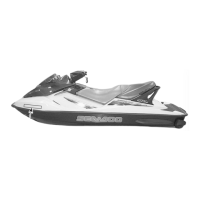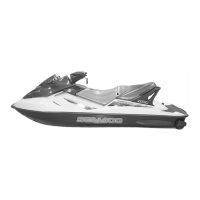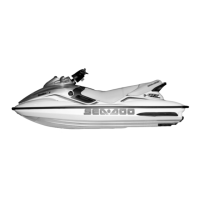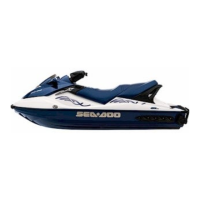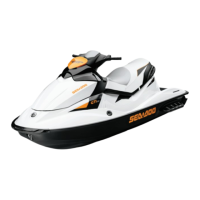OPERATION
Collision Avoidance
Do n ot release throttle when t rying t o
steer away from objects. Yo u need
throttle to steer.
Always keep a constant lookout for
other water users, other boats or ob-
jects, especially when turning. Be
alert for conditions that ma y limit you r
visibility o r block your vision o f others.
Respect the rights of other recreation-
ists and/or bystanders and always
keep a safe distance from all other
craft, people and objects.
Do not wake or wave jump, ride the
surf line or attempt to spray or splash
others with your watercraft. You may
misjudge th e ability of th e watercraft
or your own ridin g skills a nd strike a
boat or person.
This watercra ft has th e capability o f
turning more sharply than other boats,
however, unless in an emergency, do
not negotiate sharp, high speed turns.
Such maneuvers make it hard for oth-
ers to avoid you or understand where
you are going. Also, you and/or your
passenger(s) could be throw n from
the watercraft.
Like any other craft, this PWC has no
brake. Stopping distance will vary de-
pending on initial speed, load, wind,
and water conditions. Practice stop-
ping and docking in a safe, traffic free
area to ha ve an idea of how lo ng it will
take to stop the watercraft under vary-
ing conditions.
Maintaining or increasing speed may
be ne ce ssary to avoid a collisio n.
Safe Riding
Always keep in mind that as the throt-
tle lever is rele ased to idle position,
less directional control is available, and
as the engine is off, directional control
is lost. You need throttle to steer.
Ride within your limits and level of
riding ab ility. Avoid aggressive ma-
neuvers to reduce the risk of loss of
contro l, ejection and c ollision. Under-
stand and respect the perfo rm a nce or
your wa tercra ft.
Always ride responsibly and safely.
Usecommonsenseandcourtesy.
While your watercraft has t he ca-
pacity of operating at high speeds, it
is strongly recommended that high
speed operation only be applied when
ideal conditions exist and are permit-
ted. Higher speed operation requires
a higher degree of skill and increases
the risk of severe injuries.
The forces generated on the body
of riders while turning, negotiating
waves or wakes, operating in chop-
py waters, or f alling off the water-
craft, especially at higher speeds, may
cause inj ury including the possibility of
broken legs and other bones or more
serious in juries. Remain flexible and
avoid sharp turns.
In shallow water, proceed with caution
and at very low speeds. Grounding
or abrupt stops may result in injury.
Debrismayalsobepickedupandbe
thrown rearward by t he jet pum p onto
people or property.
Do not use the watercraft’s reverse, if
so equipped, to stop. You or your pas-
senger(s) could be violently ejected
forward onto the handlebars or e ven
off the watercraft onto the hazard.
PWCs are not designed for night-time
operation.
14
___________
SAFETY INFORMATION
___________
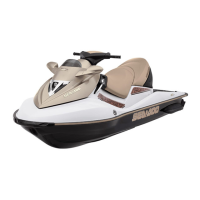
